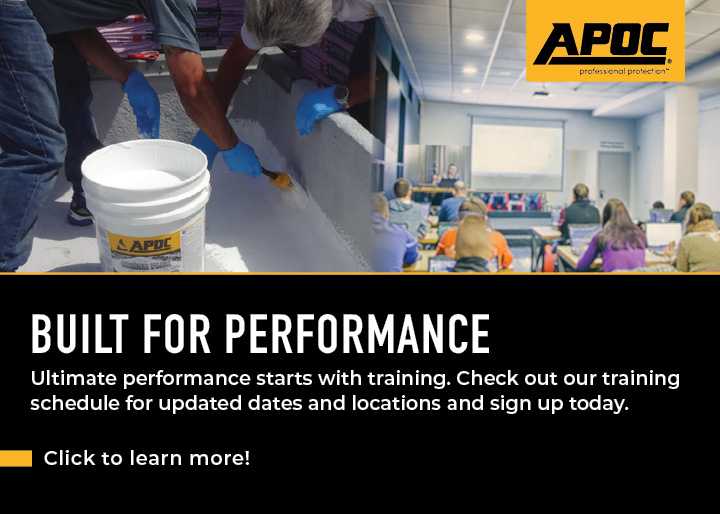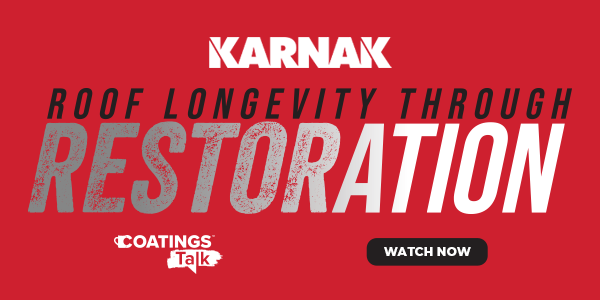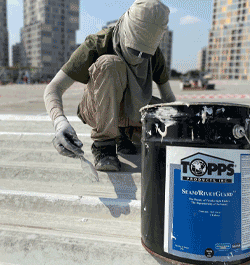UP TO THE MINUTE
Roof Longevity Through Restoration - PODCAST TRANSCRIPT
March 11, 2024 at 12:00 p.m.Editor's note: The following is the transcript of an live interview with Chris Huettig of KARNAK. You can read the transcript below or listen to the podcast.
Heidi Ellsworth: Hello and welcome to CoatingsTalk from CoatingsCoffeeShop and RoofersCoffeeShop. My name is Heidi Ellsworth and I am so excited to have you all here today on this Friday afternoon. We are going to be talking about roof restorations today, and it is the hot topic in the industry. I'm telling you. Every time we turn around this is what's happening. There is so much demand for it from the building owners, architects. And so we wanted to bring the experts in from KARNAK with Chris Huettig to talk about roof restoration.
So before we do our introductions, let me just do a little bit of housekeeping. This is being recorded. It will be available within 24 hours. And actually, with this being on a Friday, it will be available on Monday so you can share it within your business with your friends and family. This is the kind of information that can really help grow your business. We also will be taking questions throughout the entire presentation, which will last for one hour. So stay tuned and keep asking questions as we go along. But first, let's start with some introductions.
So Chris, welcome to CoatingsTalk.
Chris Huettig: Thanks Heidi, I appreciate it, all those nice things there are written on the screen. But one of the things I just cherish the most is I've been in the roofing industry for 29 years. For 25 years I've worked at KARNAK. So I've lived breathed the roof restoration history. It feels like a history. It's been around a long time, but there's been so many changes in the past 10, 20, 25 years that I'm excited to talk about today. So many people are talking about coatings. Our chemistries have evolved over the years. We're really being recognized as having fluid applied systems that are durable and flexible and dependable. So I think all that kind of buzz has really helped create a good backing and support for the coatings restoration industry.
Heidi Ellsworth: It really has. I mean, talk about an expert. You are involved in this day in and day out with such a great history. So that's what we really want to talk about today, is that restoration. What can we be doing to help with sustainability, all the different things that go along with roof restoration. So we really want to have everyone asking questions. The chat is open. So please let us know who you are, where you're from and what kind of business you have. We're also going to have some polling questions throughout, so we'll be able to get some fun information that way too. So let's go ahead and get started.
So we want to start out with our polling questions. So we are going to launch that right now. You should see on your screen where you can answer some questions. The first one is, did you offer coating restoration services to your customers last year? Second one is, if you did not offer coating services last year, do you plan on offering coating services to building owners in the coming year? We would love to know what you have to say. We're going to give everybody a little bit of time to fill that out. And it looks like we are getting a lot. Yep, there you go. Be sure to get to the second question. I'm seeing that right now. Perfect.
So Chris, once we show these results, which I think is really interesting because I think you're going to find this very interesting. In fact, we'll go ahead, if everybody, if you have one more, go ahead and snap that in. Okay, we're going to go ahead and end that poll and we're going to share results.
So the results that you're seeing out there are, Chris, overall on the first question, did you offer coating's restoration is 91%, yes.
Chris Huettig: That's great. That's much higher than I thought it was going to be.
Heidi Ellsworth: I know.
Chris Huettig: So we've got a lot of experienced coating people here today.
Heidi Ellsworth: A lot of coating people. And the next one's even more exciting. If you did not offer, are you going to offer this year, 83%.
Chris Huettig: So of that small 9%, it looks like we're capturing almost all of them. That first number will be, next year if we had the same talk, it'd be almost 100%.
Heidi Ellsworth: Exactly.
Chris Huettig: That's great.
Heidi Ellsworth: Exactly. So that is great. So let's talk about that a little bit and let's really go into why roof restoration with coatings. Chris, you're the expert. Obviously they either are or they plan to, so why?
Chris Huettig: Well, when I hear this question, when I think about this question, I want to think about it from the answers there from really the building owner's perspective. But as a contractor, you want to hear that because those become your selling points of how you then go to market to sell a building owner on a coating restoration system. The first one is really is cost. Usually all building owners, they have tight budgets, they never have enough in their budget for roofing unfortunately. So they're always looking for something if it's going to be a solution, their ears are open. And the coating restoration systems generally are a quarter of the cost or 1/3 of the cost of re-roofing. So that opens their eyes right there.
Disruption is another one. Some customers that really plays a game, they have a building where there's manufacturing going on inside activities that they can't shut down. Or it could be a school and they can't shut classes down or a hospital where they just can't turn out the doors to let you do your work on top. So whatever roofing that can be done, if it's less disruptive, again, it's more advantageous to them to look at that alternative.
From a longevity standpoint, we get asked that question, "Why do I want to use a coating restoration system and what service life do I get out of it?" I mean there are lots of different coatings out there, many great ones. And the service lives typically are five to 20 years you get out of a coating system depending on the product, the specification, the application rates and so on, but one of the great things about a coating restoration system is as that coating comes to the end of its service life, you can recoat the coatings in many cases with the technologies out there. So you are allowing that coating to perform on and on and on, which makes it great.
And that plays into the last benefit there is, is sustainability. Coating restoration systems are a sustainable option to really maximize the service life of the roof. So we can not have to deal with the unnecessary waste going into our landfills, which are piling up. So again, that owner's asset is lasting longer and we're putting less waste into our landfills, which is good for everybody.
Heidi Ellsworth: Yeah, exactly. I think this is the topic that building owners are talking about, that consumers are talking about, tenants are talking about, "How is my building sustainable?" Everybody wants to kind of understand that. I think one of the things, as you're looking at that, is really ongoing maintenance. So there's roof restoration but then there's roof maintenance which really kind of helps on all of those levels. So Chris, let's talk a little bit about why should contractors really be looking at that service and maintenance program with coatings?
Chris Huettig: Well, the roof restoration kind of process, it all begins with that roof maintenance. It's all being on the roof and selling proactive maintenance contracts to building owners. I always tell building owners, "That is the best thing for you to have, is a good contractor who's performing biannual maintenance inspections. You're going to get so much return on your dollar there."
There's studies out there that have shown with a proactive maintenance program that the building owners per square foot cost per year to maintain that roof is half as much versus not having a proactive maintenance program in house and signed. So it's so important for them that their actual overall cost of their maintaining the roof is going to be less with that proactive maintenance program in place. The other side of that is the same studies show that roofs with proactive maintenance tend to last 60% longer, have 60% longer service life. So it's a double bang, it's costing less per year and they're getting more of that expensive roof assets. So those two stories play well with building owners and understanding why roof maintenance is so important.
There's other things too, is if you're maintaining a roof and there's tenants inside because it's leased out or it's your own facility and you have the different departments working, they're going to be happier knowing that they're not having to deal with roof leaks all the time because you're proactively maintaining the roof. You have eyes on the roof. You're able to take care of things early before they turn into problems. There are tax incentives too that make it advantageous to a building owner from their perspective. Roof maintenance is taxable the very year it's done and paid for versus just letting the roof go and having to re-roof and having that amortized over a long period of time. Just from that financial standpoint to a building owner maintenance financially makes more sense than re-roofing does.
And it's all about protecting the asset. One of the things we don't think about in roofing because we don't talk about as much, but not only does maintenance protect the roof, but it also protects that building owner's assets inside. And that asset is people. People aren't getting hurt, they're not slipping and falling, there's not water causing mold and mildew to grow. And their assets, their equipment, manufacturing equipment, their inventories are being protected better as well. So it's just a great thing to have the roof maintenance program in place. Again, makes everybody inside happier and really improves the overall building comfort inside and makes everybody inside happy as well.
Heidi Ellsworth: Yeah. And contractors are finding such success with service and maintenance programs. I mean we hear that every day.
Okay. As contractors are out there and they're looking at roofs and they're talking about maintenance programs and then they're also talking about roof restoration. Let's talk a little bit about what determines roof restoration work needs because they're kind of looking at it both ways.
Chris Huettig: Okay. Well if you're a contractor and you're thinking about, "Maybe I can offer a roof restoration system. What kind of things do I need to put in play and be thinking about?" The first thing is the roof type. You need to know what's up there. Do your homework on that to make sure that you're thinking about using the right solution for the right type of roof because it's not one bucket goes over everything. So you want to know that. In doing that and doing your due diligence and talking to the building owner or the building managers, find out what kind of common problems have they had on this roof. That can kind of help you understand and maybe pinpoint and look at an area of the roof a little more carefully so that you're coming up again with the best solution that's going to solve their problems for everybody.
It's also good to know when you're doing that investigative work, how many roofs are on there. Because with the building code into play, you can only put two roofs, knowing that ahead of time helps give that information to a building owner who really knows, "You know what? I really need to think about this restoration system because it's my only option. If I don't do anything, then in a very short time I'm probably going to have to put a new roof on and absorb that cost, whatever it may be." And then with all that coming into play, knowing what type of roofs, you can then do some homework and figure out what are the best products out there based on the conditions that you have in this potential project.
Heidi Ellsworth: So let's find out from our audience a few more polling questions here, but we are... I'm going to go ahead and launch this so you'll see that right now and you can answer it. But to what Chris just spoke about, we're curious on if you could... Let me try to get that straight again. If you could rate your level of comfort with liquid repairs, mastic sealants on a scale from 1 to 10, with 1 being the lowest and 10 being the highest. Same thing on rate your level of comfort with liquid roof coatings and systems. And same thing on rate your level of comfort in finding information on coatings applications on a scale from 1 to 10, with 1 being the lowest and 10 being the highest. So you'll see all three of those questions in your polls. If you could all take a moment to answer those, that would be great.
So Chris, as people are answering these questions, really there is a lot about a comfort level of understanding the products, understanding the installations, understanding what you need to do. And we're going to talk a lot about that today, but how important is that to you and to KARNAK to really provide this education?
Chris Huettig: It's extremely important. We feel like every bucket that we sell, we want to open it up for the contractor so they can not only see it but also understand how it's used. And we feel like we do a lot of trainings out there to try to get that comfort level and feel like it's really the best piece, because It's not only comfort level, but it's also confidence. We want that building owners to not only understand, "Okay, you told me how to use it," but we want them to believe in it and have success with it. And those success stories of using your product in certain situations really helps build that confidence up in the product, in the application and what they're doing.
Heidi Ellsworth: That is so true. So it looks like I'm going to leave this just for a few more seconds if you want to go ahead and get your answers in and then we can show the results so far.
Okay, I'm going to go ahead and end poll and we are going to share results. It looks like... Oh, there we go. It looks like we're going from really a 1 through 8 on comfort on the liquid repairs and basically a 3 through 10 on answering it for liquid roof coatings. A lot higher, but 3 through 10. So across the board we have all different levels comfort here.
Chris Huettig: That's interesting. So we got a wide spectrum of those that are familiar with it because we had 91% selling coatings restorations for putting them on, but it looks like maybe the comfort level isn't quite there yet. So maybe they haven't done so many projects or still need some help there.
Heidi Ellsworth: Yeah. So this is great, and it leads right into where we're going. So what we want to talk about is really the roof life cycle. And when as contractors are getting on there, whether it is through maintenance or through bidding a job, looking at jobs, determining really is this roof a good candidate for roof restoration or not. You have put together a great chart that we're then also going to go deeper into. So Chris, maybe explain this chart and just kind of how contractors can be using this.
Chris Huettig: Yeah, this is a neat chart we have. It's the roof life cycle. It kind of puts it on a linear scale. I am a visual person so it's nice to see this. So on the far left is a new roof. On the far right would be a roof that is totally failing and would need to be replaced. So when you look at this, we have three different colors you notice, the green, which is a repair and maintain, the orange in restore and the red is replace.
The roof itself is an asset to a building owner. So if you kind of think about that, on a building owner's balance sheet, they want an asset to remain there and they want that roof to be maintained to be an asset for that company. So they really want to work to keep it in that green section. But as a roof gets neglected, as a roof is exposed to the environment and wears down, it kind of falls into that orange category in the middle there, what we call the restore phase. And we'll talk about each of these a little bit more in depth on the slides to follow. But anything in the orange phase is starting to not be an asset for that building owner and we want to help them get that roof back to being an asset.
And then on the far red, that's where that roof, instead of being an asset, it's a liability for them and it needs to be replaced. It's not helping them at all. It's not adding to their business. Think about it as if they were to sell that building tomorrow, if it's in the green, it's an asset, it's going to help them sell. If it's in the red, it's a negative, it's a liability. They're going to have to add money and fix that roof before they would then sell it. And no building owner wants to be in that position. So our job as contractors and manufacturers is we want to help building owners to stay on that left side to be in that repair and maintain. And we're going to talk about that in the slides that come up here.
Heidi Ellsworth: Excellent. So let's go on to the green zone. And like you said Chris, we want to get down to really which do each of those zones from that chart mean. So talk to us a little bit about when a contractor sees the roof and they can put it into the green zone for restoration.
Chris Huettig: Yeah. When I do roof evaluations in my mind, I kind of put them into those silos, the green, the orange and the red. So the green zone when we're evaluating a roof is a roof that really, it's maybe up to 10 years old. It's got a lot of service life to it. Maintenance is very important at this phase. And that's typically all that is needed, is a good biannual maintenance program. And with that maintenance program, it's inspecting the roof, cleaning out drains and scuppers. It's putting new caulking where that needs to be placed as it wears down and all those good things that we do on our proactive maintenance contracts. This may also mean it had a coating on the roof. The coating is worn down and now it's time to reapply that coating. So it continues to be that sacrificial layer protecting the roof underneath or it's a building owner that is really conscientious of that energy savings and they want to keep that roof white. So those are opportunities to maybe add a layer of a reflective coating.
The work done in this maintenance zone is really the most important on the longevity of the roof. The work done here, the penny spent here are going to add to the many dollars later on as that roof lasts way beyond its service life. So we really try to hone in on and get contractors to sell to building owners and tell them that story that we need to really maintain the roof from day one.
Heidi Ellsworth: So as they're going onto the roof then and really looking at that next thing, then they're going to go to orange. So what's that?
Chris Huettig: Yeah, orange is where, "You know what? This roof is, maybe it's got some neglect." Maybe they didn't have a good proactive maintenance program. There's a little more visual deterioration on this thing. It is showing its age, wear and down. So besides just doing some of the maintenance and maybe touching up and some small resealing of some flashes and such like that, that membrane surface needs some love. So we need to do a little more of a think on the restoration side. It may not just be a reflective coating, maybe we need to put down some kind of a base and a full fabric to give it a good foundation to then put that reflective coating on top.
It could be one that's had some damage from some storms, maybe there's some loose material, maybe there's insulation that's kind of lifting and we see it fasteners backing out, maybe some edge metal that's not quite secure as it should be. Those kinds of things. And it's really this orange is a critical time. The work done here is going to be more than on the maintenance side, but the goal for an orange zone roof is to get it back to that green side. And through that restoration work, most of the time you can achieve that and get that done.
Heidi Ellsworth: When contractors are talking to their building owners or facility managers, whoever they may be talking to about this, like you said, this is really a critical time because this is when they can save a lot of money by doing the right things to restore that roof before it's to the point where it has to be replaced.
Chris Huettig: Yeah, yeah. Many times in the orange zone, a building owner may be thinking if they've been on their roof or seen it or know that they've had a couple issues, they may already be thinking, "Gosh, I am going to have to put a new roof on." And they don't understand the restoration or know that their roof is a candidate for restoration. So it's such a great time to get them what they need but also to educate them as well and understand they do have choices. They don't have to let that roof just completely fail. And they got choices that are going to save their companies a lot of money.
Heidi Ellsworth: And as we look at, I mean one of your bullet points here is moisture and how important moisture is to really that determination... Sorry, there we go. That really comes into the red zone. I mean, if there's water and there's saturation or there's moisture, that's going to really put you in a spot that you want to prevent that ahead of time. So talk a little bit about the red zone.
Chris Huettig: Yeah, it's always tough getting off a roof and talking to the building owner and kind of saying that they're in the red zone with this roof. It really though the red zone, you have to draw a line in the sand. And the red zone is really not a candidate for a restoration system. Typically, the number one thing that's going to be driving that is there's water in the roof and the insulation. If there's water in the insulation of a roof, coatings are not the answer. They're not going to perform as intended, they're not going to cure as intended and everybody's going to be dissatisfied and unhappy with their experience in using it. So water saturation is something very important to find out on that roof.
In the red zone of roof, it becomes, as I said, a liability. And it's not only a liability because the structure is in question, but it's a liability for the occupants' side, for the inventories and for the damage that water when it falls into the roof can do and cause. If you're on a roof that's in the red zone, really the only thing that you can do at that point, I call it roof triage, and it's just kind of your band-aid repairs here and there, but letting the building know, "Hey, I'm going to do something here because it looks like this. What I'm doing, it's not going to last very long. You really need to think about a new roof and I'll put a plan together to re-roof this for you" and go into that conversation because the replacement really is the only thing you can do at that point.
Heidi Ellsworth: And as you're talking to the building owners, do you recommend that they really look at it and talk through explaining green, orange and red so that they kind of get that feel for it? Because a lot of facility managers or building owners have more than one roof or more than one building.
Chris Huettig: I mean, other contractors may have their way of how they categorize it. I just think if you keep it as simple as possible and everybody understands green, orange and red, we live those every day we drive, what those mean. It's a nice way to just kind of put it into a bucket that they clearly understand that you can put some characteristics around each one so they understand it. And it puts some severity to the issue when there is a situation and their roof is in red or maybe even in orange to get them to move and act upon that.
Heidi Ellsworth: Yeah. And as they are really looking at doing that evaluation, it seems to me that qualifying of the roof, we may have attendees here who are kind of like, "Okay, I get it, but that's kind of hard to figure out. Is there moisture? What's going on?" I mean, contractors know. They get out there, they understand how to do it, but what are some of the good testing methods to really be sure where that roof is at?
Chris Huettig: Well, like any good investigation, start from the outside and work your way in. I think with a roof, you want to get your investigation hat, put that on. Start with maybe some aerial images, Google Maps, something like that that's online. Or even do your own footage to kind of see what's going on. Talk to the building owner. Talk to the maintenance manager who's been dealing with whatever roof issues they have been for so long. It's good to get that information.
Then start do your visual inspections. I typically will always recommend to start with the exterior. So many times in the world of leaks coming into a building, they always blame the roof. And in many cases, it's not the roof. There could be some issues with walls, with windows, maybe some coping on the outside that nobody sees, but those are things when you want to walk the perimeter to get eyes on it to kind of make some notes and see what's going on. Note any strange things in their location so that when you go onto the roof, you're able to put it together to tell the story.
The other thing is an interior. You always, if you can, walk the interior. Look for mold and mildew on walls, stain walls, ceiling tiles that have stains on them, any drips or puddles or buckets on the floor that just don't seem to be there. You obviously know some things there too.
And then safety as well. For any of those out there doing metal roof restorations, which are huge segment of the business, I always like to walk inside to see are there skylights. If I can see the underside of the metal... If there are skylights, there are a number of skylights that have the same profile as the metal panel. Unfortunately, if I don't look inside and notice them, I may not see them on the roof if that roofs been coated and those skylights have been coated over as well. So it becomes a safety hazard. So that's why I try to see those situations and understand it to keep myself in a safe position.
Once we've done that, now comes the real work. If you've got a membrane type system with insulation, you really need to do a moisture survey. And that's what I said earlier, moisture in a roof is really the number one qualifier to say whether it's a candidate for a restoration or not. So you have to do an infrared or a capacitance induction or nuclear. Those are three types of moisture surveys out there. One of the thing I always tell, sometimes when I talk about moisture surveys, contractors feel like, "Well, you know what?" I got a number on this job and if I did a moisture survey, I'm going to lose money." And that's because they're hiding the moisture survey. And they should not be hiding that moisture survey. It should be a separate line item.
That moisture survey, whether that building owner engages in a coating restoration system with your company or not, that is an asset to them. They should be purchasing that from you. But it's a snapshot of the inside of the roof, what is going on at this date and time and it is just so valuable, but it's needed to be done to help answer the questions.
And if you don't do these, some contractors have equipment to do them, if you don't, there are many great roofing consultants. You can go under ibex website and find a roofing consultant in your area, talk to them. Talk about some numbers. Maybe they can do some deals that they can put a number for you for bidding purposes. That if the roof is a certain square footage, it's this per square foot, pennies per square foot. Versus if it's higher, it's going to be another amount. Having that conversation, knowing that ahead of time protects yourself, protects the building owner and really make sure that we're all doing the same thing, working to get a dry roof that's going to have a lot of service life left.
Heidi Ellsworth: And we had a comment in the chat and a question on core cutting, where does that all fit in? Core cuts.
Chris Huettig: Typically, in the scheme of what I show up there, you do a moisture survey. A consultant doing that moisture survey typically does two types of surveys. The second one is to validate the first one to make sure what is showing wet. And then they'll use core cuts to verify. Now sometimes that's done after two different moisture surveys or sometimes it's just done after the first survey. But that core cut allows you to say, "If this area showed as wet in my survey, let me verify it is wet." Because there are some roofs out there that have some anomalies. Usually seasoned consultants are going to know that and they will bring that up with you. The other thing about a core cut is you need to do that to find out how many roofs are on a roof and the composition. So it's always good to know if you have one or two roof systems on there and what the insulation layers are and everything built in there.
Heidi Ellsworth: Perfect. We had another question about manufacturer's warranties and I am saving that because we're going to be coming up to that.
Chris Huettig: Okay.
Heidi Ellsworth: So don't think that I forgot that. I'm just checking in the chat right now to make sure in question, so we'll get back to that warranty question.
So let's talk about roof frustration considerations. So we just talked about analyzing the roof, really understanding what it is. Let's talk about what are the considerations as you start moving down that road for a restoration.
Chris Huettig: Okay, the roof restoration considerations. Now, take a look at this from the contractor's perspective. You need to know what the condition of the roof is. You need to understand what the history of it is. So again, having conversations, you need to know where the leaks are. Not every building owner is going to be as forthcoming on what work has been done. Sometimes they don't have the history. People have left and come and gone and those are gone as well. But when you do your roof survey, you're going to tell and see which areas are patches, which areas are not and kind let you know you might have to do some additional work in some areas or additional replacement removal of materials there. Always good to know.
Other considerations of maybe thinking about a restoration versus a re-roof is the accessibility. There are some places that the building owner may be thinking of a new roof, but you can't get a crane in to get 10-foot wide rolls of whatever material, single ply material it may be or torches can't be used or you can't get a hot asphalt kettle, whatever the situation may be that work. Some 5 gallon buckets and some reinforcing fabric that's 3-feet wide can easily be brought into the middle of a plant, easily put into a service elevator that gives you that accessibility to that small manufacturing roof that's in the cluster of buildings that this company owns or get on some kind of a small high rise in an urban area and allow you to do the work. So it's always good to know those questions and think about that in the process of what you're going to offer.
What the building owner's needs are too. Do you have a building owner that's looking to freshen up their roof, kind of do a light restoration, we may call it and be looking to sell the building in a year or two? Or is this a building owner that's going to hang onto their building like a school or a hospital so they want a more robust restoration system, maybe a full fabric and maybe some other things to ask your manufacturer about. Always good questions. And then ultimately, it becomes budget too. What can they afford based on what they need, and kind of help slice it up and see what can be offered.
Heidi Ellsworth: When you're talking about some of these re-frustration considerations and you're talking about your building owner needs, that's really where you want to bring in the maintenance conversation also, right? Because talk a little bit about that conversation between ongoing maintenance, "But hey, we've evaluated your roof. Your orange, so we need to do this." How does that conversation look with them?
Chris Huettig: Well, you really want to have a conversation of the situation they're in likely is just because, "The proper maintenance hasn't been executed well on this roof. And that not only today we're talking about a problem you have, let's solve that problem. But moving forward you really need to have us in place to help monitor this roof so that you don't have the same situation come up again in 3, 4, 5 years. You're able to help maintain the roof." And it's all part of it. It's all part of we need to maintain everything we have, whether it's a car, our homes or a roof. We need to have eyes on it, it helps. And we're able to take care of problems.
And again, for a building owner, the amount of money spent is going to be less per square foot per year to maintain that roof than to keep the money in the pocket and then wait, say five years down the road, and only fix it because you had an issue. The chances are, when you do do that, the cost of that issue is going to be way more than if you had that proactive maintenance contract already in place year after year.
Heidi Ellsworth: Right. Right. Excellent. So as they are looking at that roof restoration and you're having that conversation that we're just talking about, the benefits not only to the building owners, but also what are the benefits for the contractor on really offering this kind of service, the roof restoration, the ongoing service and maintenance? So maybe talk a little bit about that, Chris.
Chris Huettig: Yeah, when we hear benefits of roof restoration, a lot of times we just go into, "Oh, it adds a protective layer and all that." All that's for the building owner really. This slide here speaks to the benefits from the contractor's perspective. And really one of the first ones there is the reduced labor needs. When you're looking at your company, roof restoration systems typically need less manpower to do the work versus a re-roofing job where you have a much greater team of people. Labor's hard to find in the roofing industry. We all know that. Labor's hard to find in construction, so it becomes very difficult to find those big teams.
So if you think about it from the standpoint of, "I could employ all my resources and be doing a re-roof, which may or may not be making me a lot of profitability for my company, or I could have the same number of people doing three different independent restoration, coating restoration projects, independently going at the same time with higher profitability," it really opens your eyes to say, "Wow. You know what? I can work with smaller forces to do the restoration and I'm more profitable at doing it." It just really makes more sense from a business perspective for them as well.
And doing restoration, it's all part of that starts with maintenance, then it goes to restoration. And it really builds that trust and relationship because eventually, roofs are going to need to be replaced. And when a building owner does look to replace a roof, they're going to look at, "Who's been maintaining my roof? Who's been on it? Who knows it the best?" Well, company X has been here all the time, they're going to give you the job to do the restoration. So it's building that trust up, which is great for opportunities. Again, having that maintenance and contract in place is the first key that establishes that trust and relationship contact that then leads to restoration, that then leads to re-roofing, so very important.
And then on the margin side, as I mentioned, when you look at the margins in the roofing industry, new construction... Now, I'll throw some numbers out. They're again across the country so they may be different depending on where you're at and all. But usually, typically a new construction re-roof, you're making 10 to 20% profit on something like that. And again, it could be a lot of people employed, a lot and lot of resources. When you're re-roofing, it's a little bit better. You're making 15 to 30%, so it's more profitable for you.
Now when you go to the restoration side of it, it gets even a little higher. Usually the margins are 30 to 40%, so much better. And then one of the highest margin parts of the business is going to be the repair and maintenance, which is more of the 50 to 70%. So again, you start off with that repair and maintenance, you're not using a lot of people, you're making a very good profit for your company and it's going to lead to the restoration part of it. And it's really a good segment of the business that sometimes that gets missed and it's so important to have that.
And then the last part of the benefit to the contractor is that these restoration systems can come with a warranty. Manufacturers, we offer warranties with ours. And with any warranty, there's always the part that says the building owner needs to maintain the roof. So again, that's triggering that maintenance section. A maintenance contract needs to be signed on and it gives you the opportunity to sell that maintenance contract to a building owner. So yeah, to answer your question, there are warranties offered with coating restoration systems. Like any warranty, the roof needs to be maintained. And that allows you to sell the maintenance contract to help keep that warranty in place and to help keep that roof going right along.
Heidi Ellsworth: Well, we're going to ask, in fact, we're going to get into more into warranties. And that was the question, what type of manufacturer's warranties do you offer? So let's ask this poll question first and then we will answer that. And I'm going to launch that right now. So if everyone could just take a second.
How critical are warranties in your roofing services offering? Very critical? Moderately? Or not critical? And go ahead and answer those and we'll get that out there. But really, that is such an important question of how do warranties work and how are people putting all of that together. So as soon as we get this poll question answered, Chris, I think we'll be able to go into that.
Chris Huettig: Okay. Yeah, I'm interested to see the answer on this one here.
Heidi Ellsworth: I know. We have a few more folks out there who are coming in. Okay. Looks like we have going to end the poll and share results. It looks like 89% say very critical with just a little bit of not so critical. Interesting. Very interesting.
So Chris, why don't you talk a little bit about answering this question, what type of manufacturers warranties do you offer?
Chris Huettig: Yeah, at KARNAK we offer material and material labor warranties from five to 20 year. That's typically what is the industry uses and has out there as a tool. The warranties are sometimes important. And it looks like to our people on today, they're very important. Some of the plays, I like that because again, every warranty requires a building owner to maintain the roof. So it really plays into any contractor selling a warranty needs to have their maintenance contract right behind it. And at that same time, that they're handing over the warranty, they did a job well done. Have the building owner sign that maintenance contract. It's the great time to have that conversation because it says right in our warranty as well as others, there's work for that building owner and they need to maintain the roof. That's the best win and they're going to get the best experience understanding that.
So it doesn't surprise me that that's high. That's what I hear from our salespeople all the time, asking me, "I need a warranted system and go through that." I like it because also we're able to get boots on the ground. Because if there's a warranty, that means we're having conversations before the project even bids to make sure everything's in line, we're doing the right things. We call it a tech talk kind of what we do that with our salespeople and with the roofing contractor and our technical group. And then we're going to be on the roof taking a look at it during the process, inspections during the way at the start, at the interim inspection in the final to make sure the contractors know what they're doing and understand it and such to make everybody happy and to close it out. So it's good to see numbers like that and that's kind of typically what I thought I'd see there as well.
Heidi Ellsworth: Exactly. And you know what? Let's talk just a little bit about recoat warranties because there's a number out there that after a certain time you recoat it and that extends the warranty. How does that work?
Chris Huettig: Yeah, we would do the same thing. If there was a warranted coating system in place, let's just say it was 10 years and it's getting towards the end of its life, the building owner, the contractor can contact us, we can do a roof evaluation of it. And if everything is in place, they can apply another coating, whatever that coating system was, reapply the coating on top of what's there and get another warranty of the same or equal or longer length based on what they do. So it's really easy just to keep adding onto that warranted time period based on their conditions, but there's so much faith and trust and technology in the coating systems out there that we're able to do that. So happy to help everybody out.
Heidi Ellsworth: Perfect. And if anybody, if you have more questions on that, on warranties or overall what we're talking about, please put them either in the Q&A or into the chat and I am grabbing those as we go.
So in talking about warranties, to me that takes us directly to something that we talked about at the very beginning of this webinar and is so important out in the field, and that is sustainability. It really opens those doors to talk to building owners about sustainability and about why restoration really fits into that category. So Chris, let's talk a little bit about that.
Chris Huettig: Yeah, everything we've talked about so far, the benefits of this and that have really been for the building owner, the building for the contractor. This slide here really speaks to the bigger picture as a whole and kind of why, again, another reason why coating restoration systems are so advantageous for not only us but for the globe, the world itself.
When you think about restoration systems, there's less waste. We're not ripping off a roof down to the deck, taking all that material and throwing it into a landfill. We're taking what's there, we're refurbishing it. We're extending its service life, which just helps keep the waste in the world down to a minimum. And we all need to be good stewards for that. And that's what these coating systems do.
It also helps a contractor from the standpoint of, there's a lot of cost in landfills and taking materials to landfills too. And that cost is only getting higher and higher as landfills fill up. Those who manage those landfills don't want people to... They want to minimize the waste going in there, so a lot of times those costs go up to curb that thinking. And it does make sense. We want to keep the stuff, all our waste out of the landfill if we don't need to.
If you're doing a coating restoration systems, you're really using less materials too for that restoration and repair of the roof rather than having to put on some bulky items on here that are cumbersome to use and maybe have a greater impact on shipping as well. That's kind of something as well. The coating restoration systems kind of fit that space as we're using less materials to accomplish the goal of sealing a roof, making it watertight and extending the service life of that existing roof.
And then lastly, from an energy efficiency standpoint, with our reflective coating systems, we're reducing the amount of heat transfer into the building. We're able to reduce the effects on this surrounding environment. As that hot roof during the day absorbs all that heat and then releases it during the night, we will have cooler cities, more reflective coating and reflective surfaces on there. So from an energy standpoint, it really helps to lower and keep our cities cool as well
Heidi Ellsworth: And we just came back from the SprayFoam show, their annual show and there was a lot of talk about how SprayFoam is working with coatings on roof restorations and also just for energy savings and increasing that. So as you're using your coatings, there's a lot of different opportunities for different systems.
Chris Huettig: Yeah, foam itself is great. It's your insulator, it's your roof, but it does need a coating on top, and that coating does need to be maintained. Sometimes we run into building owners asking us the question of they want to recoat their roof, and if it is a foam roof that they have not paid attention to sometimes, it needs a little more restoration. So those are roofs that you want to keep on that coating, help keep that foam protected because it is serving a great purpose as the insulation as well as the roofing system there. And really, there's so many technology, almost every technology out there can go over foam. So there's lots of options for building owners.
Heidi Ellsworth: Right. And it all starts playing into the sustainability of the longevity of the roofs really, and like you said, trying to keep it out of the landfills.
Chris Huettig: Absolutely. Absolutely. We all have a job to do that.
Heidi Ellsworth: I know. And I mean when we think about, as we all know, certain rules and legislation come out of certain states. Florida and California tend to always be leading them, but we are seeing a lot coming out of California on recycling and not going into the landfills or trying to close that and making sure you recycle everything on the roof along with insulation levels. So there's a lot there that contractors need to be aware of where coatings can really fit the bill to take care of those building owners.
Chris Huettig: Absolutely. Absolutely. I've even known to some parts of the country where the pales, the plastic pales were used were actually recyclable. So I thought that was great. I don't know if everybody does it across the country, but if we can get everybody on board to be able to recycle our pale materials, which carry our products out there, it'd be great for everybody.
Heidi Ellsworth: Seems like that would make sense.
Chris Huettig: Absolutely.
Heidi Ellsworth: It shouldn't be that bad. Okay, great. Then let's go ahead and... This is our last poll question and we would love to get everyone's... Oh, and I'm sorry I hadn't stopped sharing that. I apologize everybody from the last one. But we're going to go ahead and launch this last one. And it is, what is the most difficult aspect of selling coating restoration work for you? So please pick those or all of the above if it's all difficult. And we just love to know what you're finding. The most difficult. Qualifying the roof is one that can be coated? Understanding coatings to use? Estimating coating applications? Understanding what steps of a coating restoration are necessary and why? How to ensure a quality application or all of the above?
And Chris, it is hard. There is a lot for companies not only as a company owner to consider bringing into their business and differentiating, but also then training the folks in the field, training salespeople, the office. So there is some difficulties in this. What are you seeing and hearing from contractors about this?
Chris Huettig: Yeah, it seems like there's a lot of information. Some of it unfortunately may be conflicting so we always say, "Hey, if you don't understand something on the coating side, let us come in." We have a nice little presentation. We can start with why repair and restoration, kind of like what we're talking about today, how to have those conversations with building owners. It's great to have great products and they work well on a roof, but if a contractor isn't comfortable in selling them and talking to them about them with a building owner and kind of understanding how can I position this versus a re-roof, we want to talk about that. We want to bring those things up. So we have those hard conversations to kind of really put bullets in their belts so they know what to go to battle with when they're going against these roofs.
And then also understanding the products. There are some products out there that seem to do everything, and then some that are very niche products. So what information can I gather to kind of filter through the right product for the right application? We spend a lot of time doing that.
Training. Again, being in the coatings industry, 25 years ago, if you wanted a roof white, I always jokingly say, "Here's a bucket, clean it and apply two coats." And that was kind of just the general industry knowledge. So starts off with cleaning. What does cleaning mean? If I ask three people what cleaning means, I'm going to get three different answers. So those are things we needed to hone in on and say, "We need to really train people, get very specific on this so they know exactly what they need to do" because cleaning and preparation accounts for almost 70% of a coating failure is related to that. So we want to get them trained in the right information, tools and knowledge to understand how important cleaning is so they set a good foundation for that coating restoration system.
Heidi Ellsworth: That makes so much sense. And it sounds like another webinar to me as we talk through that.
Well, we're going to go ahead and end the poll. And it's very interesting. It looks like across the board we are seeing all of these areas are definitely the... We have some from all of the above, 30% on how to ensure a quality application, 30% on understanding what steps of a coating restoration are, 10% on estimating, 30% on understanding what to use and 10% on qualifying the roof as the one that can be coded. That's really interesting because it's really across the board. So these kinds of webinars and training that you are offering, Chris, you can see it's incredibly important. I am going to remember to stop sharing that time.
So let's talk a little bit about that next on where to go for information. I think this is super important. And in the meantime, as we finish up on this slide, please if you have any questions, ask them now, get them into the chat or the Q&A. But this is really where you're going to find additional, even more than what we've already talked about today. So Chris, let's start out with the RCMA. They have a lot of great stuff.
Chris Huettig: Yeah, the Roof Coating Manufacturers Association, I'll just put on my head, I actually serve right now. I'm fortunate enough to serve as the president of the RCMA. But it's a great organization that is out there to help coating contractors. One of the things, tools they do have, there's a virtual training program. There's three modules. And it's really just some basic coating and information. It's non-manufacture specific, but it's very, very helpful that if you're getting into coatings or you have other people in your company that want to know more, they're maybe not as seasoned as you in coatings, very good to log on. The website for the RCMA is roofcoatings.org and you can go there and look at their virtual training program.
Next is the NRCA. They have lots of good information there. And a lot of times coating restoration systems, you may look on a roof and see wondering what something is going on in a roof and need the information of how is that existing roof system put together. NRCA is great. It's a great tool I use. I look at their details to kind of understand how I'm going to have a sealant go on in detail or maybe what is going on with a roof. Great resources there.
The next is Distribution. A lot of coating products are sold through Distribution, so there's good seasoned people there at the counter and inside and outside salespeople that are willing to help you. If they don't know what's great is the Distributor is going to find a great manufacturer like a KARNAK and put us together with you so that we can help answer questions you may have.
And then lastly, there's KARNAK. we have a number of great initiatives here. One of them being KARNAK University. We have a free online learning platform that offers 16 short ten-minute courses on roofing. And a lot of these, it's not a KARNAK commercial on a product. It's actually just as I mentioned earlier about sound basic preparation techniques for cleaning. We talk about some tools and some things done out there. I mean, after watching those, we'd hope you use KARNAK products. But if you didn't and you use one of our competitors, you're going to be using it in a better way in the right way. We created that just to raise the level of the coatings industry.
If you take those KARNAK University courses, you earn a little graduate certificate. We play up on that and you get a graduation gift. So it's fun to do anyway, and you do learn a lot. You can go to karnakcorp.com to find that information out. And there's a resource tab there to find KARNAK University. We also have a number of great videos there. They're real short videos, usually one to three minutes. They have some products opening up so you can see what the product looks like, see how it's being applied in there, just to get a good general idea.
And then we also have a little key there. You can download our mobile app. Our mobile app is a great tool. It's not our website, it's a mobile app that goes on your phone and really just gets you a list of our repair products. There's a great button there for a solution finder that you can walk on a roof and put in what type of roof you're on, whether it's coated or not coated. And it'll kind of point you to these products are for repair, these products are for coating. Really, really helpful there.
There's also a report button on there that allows you to kind of create some very simple reports that you can do a roof inspection and get a PDF to a building owner very quickly even before you walk off the roof. That's got a nice voice-to-text so you can kind of look at something, snap a picture of it, voice-to-text, what you see and what you're planning to do. And that building owner has it so they know what is going on with their roof. And also lastly, it's got a button for KARNAK contact information. If you just, "I need to talk to somebody or I need an email," we can help direct you there as well.
Heidi Ellsworth: Yeah, you have some of the best out in the field who are out there helping people every single day.
Chris Huettig: Yeah, we got a good team. We got a good season. Like I said, I've been here for a while and a lot of the ones I work with are sales reps and technical people. We've all been at KARNAK for decades.
Heidi Ellsworth: Okay. I do want to just go back to also with RCMA and National Roofing Contractors Association. NRCA has TRAC, which has trainings on coatings. They also are working on a pro certification on coatings. So a lot of good stuff. But the RCMA trainings are really... You can go on, it's online. It's a great thing for you to take. And Chris, just I want to say congratulations for your leadership of RCMA and everything that you're doing there. What a great organization that really is there to help the industry.
Chris Huettig: Thank you. [inaudible 00:55:51].
Heidi Ellsworth: So any questions for Chris please go ahead and put them out there. I just want to say, Chris, thank you so much. This has been so informative. And of course everything that you talked about with KARNAK is also available on the KARNAK directory, on CoatingsCoffeeShop. So be sure to check that out and get all this information and get to all the great resources that you put out there, Chris. I have a question that I would like to ask, is just, what are you hearing from your contractors about the future of coatings in their business and how important is it to their overall business?
Chris Huettig: Well, it used to be a small percentage of coatings work within a roofing contractor. It was more of just kind of like a one reflective coating, and that's about all they offered. It seems now that contractors through some things like COVID when roofing materials in general for new roofing weren't available, but coatings really didn't have any lag time, that they started to look as an alternative. And when they're finding them as an alternative, they liked what they saw. They liked working with it, they understood some of those points I said that that really added benefit, and they've taken that and added it to their roofing arsenal and what they offer to building owners. So there's a lot of good momentum.
I also think that for contractors that maybe are on the residential side that are trying to get into the commercial side, that the coating restoration opportunity is kind of a gateway to that low slope commercial roofing market that they want to get involved in. And selling maintenance contracts allows them to understanding and kind of get their feet wet into that roof restoration side as well. So I've seen the numbers go up, I've seen the projections that contractors are keeping it. It looks like we got a very good, strong restoration coating market that's going to continue for many years to come.
Heidi Ellsworth: That is excellent. That is excellent. Well, I want to thank all of you for your time, for your questions, your comments. It's been excellent. And Chris, most of all, I want to thank you and KARNAK for bringing this great information out for the industry.
Chris Huettig: We're happy to help Heidi. And thank you for inviting us and having us. Everybody, have a great weekend.
Heidi Ellsworth: Everybody, thank you so much. And once again, thank you all for being here today. We've got some thumbs up and thank-yous coming through. Thank you so much. We will have more RLWs next week with our MetalTalks and also a special RLW on sustainability from LP on siting on next Friday. So stay tuned for lots of information. And please go to CoatingsCoffeeShop, visit the KARNAK directory. All of their great articles, videos, training, everything is there where you can get a lot of this information. So for all of you, have a great weekend and we will be seeing you next week again on the RLW's on the Coffee Shops. Have a great weekend.



















Comments
Leave a Reply
Have an account? Login to leave a comment!
Sign In